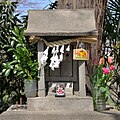This article may require cleanup to meet Wikipedia's quality standards. The specific problem is: Many problematic entries: links to non-existent Wiktionary pages, mistaken romanization, misspellings of the Japanese, incorrect glosses. Please help improve this article if you can. (July 2022) (Learn how and when to remove this message)
This article needs additional citations for verification. Please help improve this article by adding citations to reliable sources. Unsourced material may be challenged and removed.Find sources: "Glossary of Shinto" – news · newspapers · books · scholar · JSTOR (March 2022) (Learn how and when to remove this message)
This is the glossary of Shinto, including major terms on the subject. Words followed by an asterisk (*) are illustrated by an image in one of the photo galleries.
| Part of a series on |
| Shinto |
|---|
 |







































